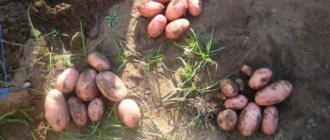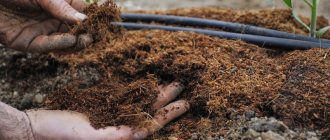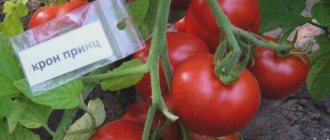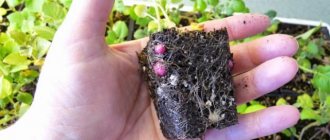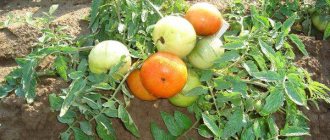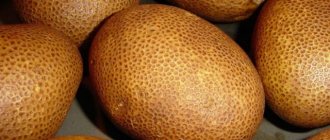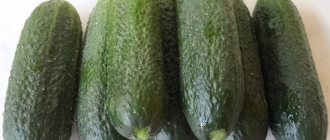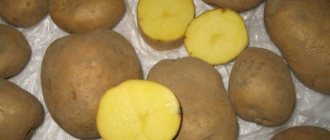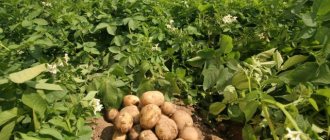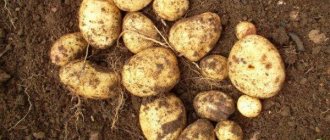History of origin of potato variety “Manifest”
Potatoes of the “Manifest” variety were bred by specialists from the Scientific and Production Center of the National Academy of Sciences of Belarus for potato and horticultural production.
The year of inclusion in the State Register of Russia is 2014.
Zoned for cultivation in Central Russia.
The table presents data on starch content in different varieties:
| Name | Variety | % |
| Nikulinsky | Late ripening | From 12 to 21 |
| Cardinal | Late ripening | 15 |
| Rocco | Late ripening | 16 |
| Ivan da Marya | Late ripening | From 8 to 14 |
| Asterix | Late ripening | 17 |
| Borovichok | Early ripening | From 13 to 17 |
| Elmundo | Early ripening | From 11 to 14 |
| Felox | Early ripening | 16-17 |
| Bellarosa | Early ripening | 12 to 16 |
| Natasha | Early ripening | From 12 to 14 |
| Forty days | Extra early | From 11 to 15 |
| Karatop | Extra early | From 10.5 to 15 |
| Riviera | Extra early | 19,6 |
| Zhukovsky early | Extra early | From 10 to 12 |
| Farmer | Extra early | 12 |
| Crane | Mid-late | 14-19 |
| Sorcerer | Mid-late | From 12 to 15 |
| Mozart | Mid-late | No more than 20 |
| Grenada | Mid-late | From 10 to 17 |
| Melody | Mid-late | From 11 to 17 |
| Yanka | Mid-early | 14,8-15,4 |
| Giant | Mid-early | 16-19 |
| Tuscany | Mid-early | From 12 to 14 |
| Purple Haze | Mid-early | 14,4-17,2 |
| Openwork | Mid-early | From 14 to 16 |
Advantages and disadvantages
- This variety has many advantages:
- high-yielding;
- perfectly stored;
- high taste qualities;
- versatility of using root vegetables;
- presentation of tubers;
- ability to tolerate mechanical cleaning well;
- excellent transportability;
- possibility of growing in different climates;
- increased amount of antioxidants;
- resistance to many diseases.
Like any potato, root vegetables of the Manifest variety serve as an excellent source of carbohydrates and contain a lot of vitamins C and B6, PP, and minerals (potassium, magnesium, phosphorus, copper, manganese, iron).
In addition, it contains more antioxidants than many other varieties, since its selection was carried out taking into account the increase in these substances. This variety has one drawback - it requires high-quality nutritious soil, which, in principle, is the norm for varieties with high yields. Did you know? Potato varieties with skin and flesh in pink, reddish and purple tones contain more antioxidants that protect our body from cancer, old age and strengthen the immune system. White varieties contain more vitamin C, and yellow varieties are superior to other types in carotene content.
Description of the variety
Roots:
- The tubers have an oblong shape, with rounded edges;
- The peel is pink;
- The pulp is light amber when cut;
- Small eyes;
- Starch content from 11 to 15%;
- Average weight from 105 to 145 grams;
- The yield from one bush varies from 11 to 15 tubers.
Potatoes and new varieties are being studied in Belarus:
Bushes:
- The plant is semi-erect, intermediate type;
- Grows up to 50 cm;
- Medium-sized emerald leaves, with a smooth glossy surface and slight jagged edges;
- Blue-lilac corollas, with a faint anthocyanin tint;
- More colorful inner side of buds with medium intensity anthocyanin color.
Characteristics of the fetus
Manifesto is a medium-late ripening table variety. From the moment of planting to harvest, about 90-110 days pass.
The tubers are large, often growing up to 150 g. On average, the weight of commercial potatoes varies in the range of 90-120 g. The starch content in the root crop is in the range of 11-15%.
Potatoes have high commercial qualities. Firstly, it is not afraid of long-term transportation and mechanical stress. Secondly, the variety is high-yielding, which allows you to collect up to 410 centners of excellent products from 1 hectare. Thirdly, the ocelli are superficial and few in number.
Main characteristics of the root vegetable:
- The pulp is light yellow.
- The skin is pink.
- Cookability is average.
Correct fit
Basic rules for planting the “Manifest” variety:
- To get a bountiful harvest, planting material is planted in light, breathable soil;
- In the fall, fertilize the soil by adding an organic mixture (rotted manure, compost, peat);
- In the spring, the soil is fertilized using inorganic fertilizers;
- A month before planting, select seed material. It is placed in boxes and exposed to the sun, periodically sprinkling the planting tubers with water;
- Wood ash must be added to planting holes 10 cm deep to improve the growth and development of potatoes;
- The distance between bushes should be 40 cm, row spacing should be at least 70 cm.
HELP: Afterwards, be sure to dig up the soil.
Harvesting and storage
The harvest can be taken at the end of August or at the beginning of September. To do this, it is better to choose a dry and warm day. In 1.5–2 weeks, the tops can be mowed, leaving 10–15 cm. Thanks to this, Manifesto potato tubers ripen faster and become large.
The dug up root crops are dried in the sun for 3–4 hours and packaged in bags. Small ones can be sorted immediately - they are consumed first. Large Manifest potatoes are placed in a dark and cool room. In the first 2–3 weeks it is stored at a temperature of 14–15 °C, and then at 2–4 °C and a humidity of 70–80%.
Care
In the future, potato plantings need to be watered, hilled and fed.
Watering
Water as needed. Water rarely, but abundantly, especially during the flowering period.
Hilling
When the potato tops reach a height of 15-18 cm, the potatoes are hilled. After two weeks, re-hilling is carried out. Weeding is mandatory, pulling out weeds.
We invite you to familiarize yourself with potato varieties that have different ripening periods:
| Late ripening | Early ripening | Very early | Mid-late | Mid-early |
| Nikulinsky | Borovichok | Forty days | Crane | Yanka |
| Cardinal | Elmundo | Karatop | Sorcerer | Giant |
| Rocco | Felox | Riviera | Mozart | Tuscany |
| Kiwi | Bellarosa | Zhukovsky early | Grenada | Purple Haze |
| Ivan da Marya | Natasha | Farmer | Melody | Openwork |
| Picasso | Ariel | Minerva | Margarita | Santana |
| Asterix | Queen Anne | Veneta | Ramona | Desiree |
| Slav | Arosa | Kiranda | Dolphin | Lady Claire |
Feeding
When the tops reach a height of 8-10 cm, fertilizing is carried out: manure and clean water are diluted from a ratio of 1:10, then 1 tbsp is added to the mixture. l. superphosphate.
REFERENCE: During hilling, apply fertilizer directly to the root, avoiding getting the fertilizer on the tops.
Step-by-step instructions for growing
Cultivation is carried out traditionally, grown in open beds.
Inventory
For cultivation you may need the following tools:
- Motoblock.
- Cultivator.
- Shovel.
- Pitchfork.
- Hiller.
- Marker.
- Scriber.
Attention! Instruments are treated with solutions of potassium permanganate and copper preparations.
Preparation
The beds are arranged in well-lit areas, located in a north-south direction. Potatoes are not planted in the same place for 2 years in a row. Place at a distance from other nightshade crops.
Soils
The ideal soil for Manifest is breathable, with moderate acidity levels. At the end of August, winter green manures are sown:
- Rye.
- Oats.
- Barley.
- Vika.
- Mustard.
The best predecessors are peas and other legumes. And also pumpkin, cucumbers, different types of cabbage.
- In the fall, manure is added to the soil at a dosage of 10 kg per 1 m². They plow deeply.
- In the spring, peat is added to the beds, 1 tbsp is poured into the holes. wood ash.
Material
The tubers are sorted and left whole, without signs of damage or disease. For the purpose of disinfection, they are treated with solutions:
- Taboo.
- Baktofit.
- Copper sulfate.
- 1% Fitosporin.
Sprout tubers using any of the convenient methods:
- In the light for a month.
- In humid conditions up to 20 days.
Boarding time
Planted in a permanent place from late April to mid-May. The soil temperature should not fall below 8 degrees at a layer thickness of 10 cm. The optimal air temperature is 12-14 degrees. The length of daylight hours is 11-12 hours.
Important! If you miss the planting date and plant the material a week late, the shortage of potatoes will be 7-8%.
Planting scheme
The grooves are cut at a distance of 60-70 cm. The depth depends on the type of soil:
- In loams 6-9 cm.
- In clayey soils 4-6 cm.
- In loose sandy loam and sandy soils 10-12 cm.
The tubers are laid out at a distance of 30-35 cm.
Care
For a good harvest, Manifest is cared for in compliance with simple rules:
- They loosen within a week after planting.
- Hill up at intervals of 10-14 days.
- Feed at least 3 times.
- Clear the plantings of weeds.
- They fight against pests - wireworms, aphids, and Colorado potato beetles.
Hilling
Attention! In order for many stolons with tubers to form, the bushes should be earthed up at least 3 times before flowering.
The first hilling is carried out when the height of the bushes is 10-12 cm. Deep cultivation is necessary when the tops grow to 18-20 cm. The procedure is repeated after 20 days.
Watering
Watering begins 25-30 days after planting.
Carry out every 8-10 days in dry weather. Make sure that moisture penetrates to a depth of 40-50 cm. A month before digging up the crop, stop watering. Drip irrigation gives a good effect. 1 bush requires up to 4 liters before flowering. The rate is increased to 6-10 liters after buds are set. Water is released through furrows and sprinkling is used.
Loosening
They begin to loosen even before the emergence of shoots. The loosening procedure is equivalent to dry watering. The frequency of execution is 1 time every 2 weeks.
Loosen carefully, without damaging the developing tubers.
The beds are harrowed after each irrigation.
Top dressing
For maximum productivity, it is important to carry out more than 3 feedings - root and leaf. Fertilizers are used:
Fertilizers are used:
- Combined formulations. Nitrophoska, nitroammophoska.
- Mineral complexes. Superphosphate, potassium sulfate, urea, ammonium nitrate.
Ash is ideal for foliar irrigation. 100 g are dissolved in 10 liters of water.
What to feed depending on the stage:
| Stages | Feeding products |
| Before the first hilling |
|
| On the eve of flowering | Complex solution of:
|
| When blooming | Compound:
|
Diseases and pests
Potato variety "Manifest":
- Has high immunity against cancer, golden cyst nematode, leaf curl, striped rugose mosaic;
- Moderately resistant to late blight of leaves and tubers;
- It has a resistance of 9 points to viruses X, Y, L, M, and 7 points to virus S.
REFERENCE: The variety is susceptible to potato moth attacks.
Pests are able to penetrate stems and roots and devour foliage from bushes. As soon as the moth appears, the stem immediately dies. There is no harvest or it is in small quantities. Also an enemy of potato plantings is the Colorado potato beetle and its larvae. They fight them using folk remedies and chemicals.
Agricultural technology
Germination of seeds
Two days before planting, the seeds are placed in cool, clean water. At night, it is advisable to put them in the refrigerator for hardening, where the temperature is up to +1 degree.
Sowing containers are filled with soil. It should have a proportion: one part earth and four parts peat. The soil is watered, and the prepared seeds are placed in containers in rows with an interval of ten centimeters. Cover the top with a layer of sand no more than five millimeters thick. Then they are compacted slightly and covered with glass or film.
Storage temperature should be warm. Every day you need to open the containers for half an hour for ventilation. It is necessary to periodically water the seeds, then in a week sprouts will begin to appear.
Disembarkation
It is advisable to pre-apply fertilizer to the soil in the autumn. The mixture should consist of peat, compost and rotted manure. One hundred square meters of land requires approximately fifty kilograms of fertilizer. After this, the ground needs to be dug up.
The optimal time for planting potatoes is the beginning of May. But in cold regions, planting is carried out later, when warm weather sets in. After all, planting vegetables in cold soil can lead to disease. The ground temperature should be +10 degrees. You can measure it with a simple thermometer.
In the spring, you should feed the soil with humus or chicken droppings. Before planting potatoes, loosen the soil a little. Furrows are made in the soil, the depth of which is eight centimeters. The sprouts are planted at a distance of thirty centimeters from each other.
It is advisable to use ridge planting of vegetables. It consists in placing the sprouted tubers in rows and then carefully covering them with earth in the form of a ridge ten centimeters high.
Reviews about the variety
The Manifesto variety of potatoes receives only positive feedback. The tubers not only have excellent taste, but also excellent shelf life. In terms of cookability, the variety corresponds to type AB. Gardeners value the “Manifesto” variety for its ability to cultivate on light and medium-textured soils.
The potato variety "Manifest" is a productive variety. Suitable for cultivation in open ground. It is highly resistant to most diseases typical of nightshades. Well responsive to applied fertilizing. The “Manifesto” variety, like other varieties of Belarusian selection, has gained popularity among Russian gardeners in a short period of time. That is why it enjoys well-deserved attention from both professionals and amateur gardeners.
Advantages and disadvantages
The manifesto has a number of advantages that allowed it to occupy a good niche in the market. Among the main ones are:
- Manifest has amazing taste qualities.
- The tubers have an excellent presentation.
- Manifest is a universal potato and is suitable for preparing any dish, from soup to puree.
- Quite a good yield.
- Good shelf life, up to 95%.
Potatoes also have one drawback. It is more often affected by potato moth than other varieties.
Features of cultivation
Planting potatoes
With the onset of the first autumn frosts, it is recommended to fertilize the garden with humus at the rate of 5–9 kg per square meter of plot. The garden itself needs to be dug no deeper than the height of the shovel, while removing any weeds and roots that are found. Tubers for spring planting should be stored in a cool and always dry cellar. It is recommended to select root crops suitable for future planting a month before the garden work itself. Suitable tubers are selected in a separate box and exposed to sunlight. During this period, it will not be amiss to sprinkle the tubers with a small amount of water.
Recommendation! Root crops should be planted at the same depth level. The soil must be breathable, for example, black soil or chestnut (carbonate) soil. The soil acidity level should remain average.
Planting potatoes is allowed in heated soil (at least 8 degrees Celsius) to a depth of no more than 10 cm. To measure the soil temperature, you can use a regular thermometer. If potatoes are planted in unheated soil, the tubers may be damaged by rhizoctonia blight. At the same time, a delay in planting potatoes can lead to a lower yield. The best time for such garden work is the beginning of May.
Between holes in the same row it is necessary to maintain a distance of 40 cm, and between rows - 70 cm.
You may be interested in: Dates for planting potatoes in May-June 2020 according to the lunar planting calendar When the potato harvest is harvested in Russia according to the calendar of gardeners and gardeners Dates for planting potatoes in 2021 for central Russia and the Moscow region
Step-by-step cultivation procedure
Since the yield of tasty and long-storable potatoes depends on the correct planting and care of them, you should understand in advance the sequence of the main stages of garden work:
- Harvesting ripe potato berries, which are first hung in cheesecloth in a warm, well-lit room, and then peeled to obtain seeds. The seeds themselves are washed and carefully dried. They are stored until next spring.
- Two days before planting, the seeds are placed in cool water. During the day, the container with water is stored at room temperature, and at night it is placed in the refrigerator with a temperature of 1 degree above zero. You can sow seeds only after they begin to germinate. Typically this takes place at the end of March or beginning of April.
- Sowing is carried out in boxes with soil consisting of soil and peat in a ratio of 1 to 4, pre-watered with water.
- The seeds are laid out in rows at a distance of at least 10 cm, and then covered with a thin layer of sand (about 0.5 cm thick) and lightly compacted.
- The boxes themselves are covered with film or glass. Seeds should germinate in a warm room and with regular watering. For sufficient ventilation, it is necessary to open the drawers themselves daily for at least 20–30 minutes. The first shoots should appear within 7 to 10 days after sowing.
- It is recommended to plant seedlings in beds at the end of May, when the air temperature does not drop below 10 degrees Celsius.
- During planting, a distance of at least 35 cm must be maintained between the tubers in the row. At the same time, the rows must be no closer than 70 cm to each other.
